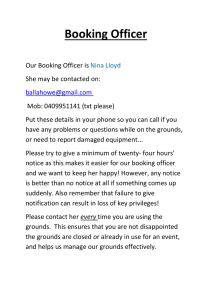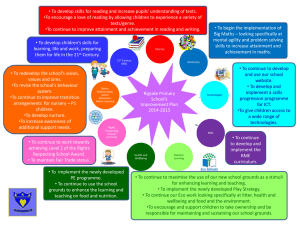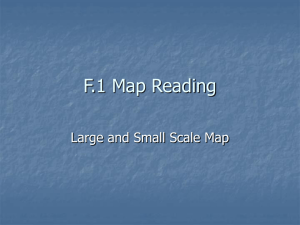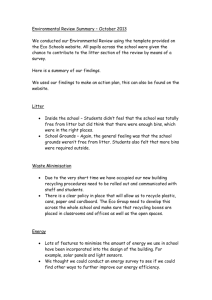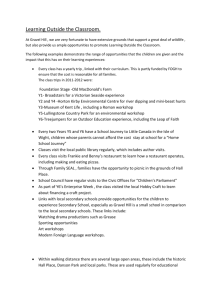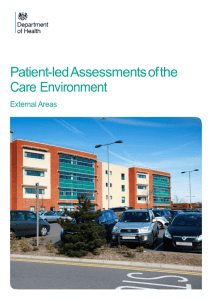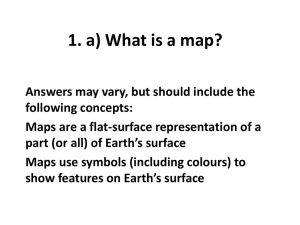scales around
advertisement
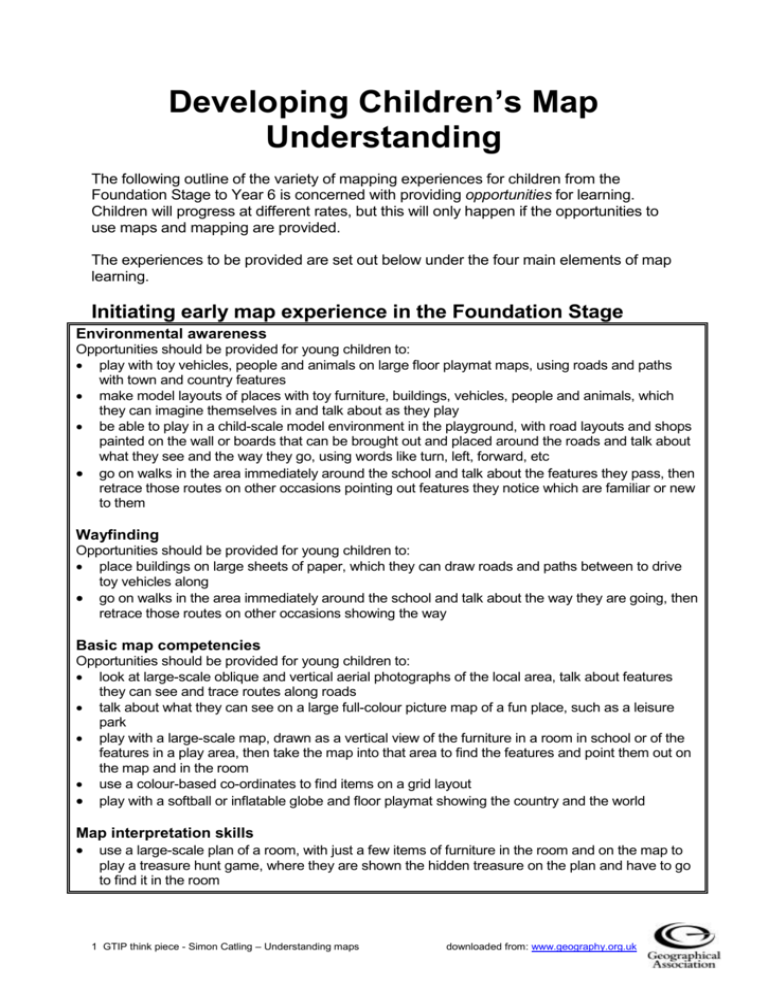
Developing Children’s Map Understanding The following outline of the variety of mapping experiences for children from the Foundation Stage to Year 6 is concerned with providing opportunities for learning. Children will progress at different rates, but this will only happen if the opportunities to use maps and mapping are provided. The experiences to be provided are set out below under the four main elements of map learning. Initiating early map experience in the Foundation Stage Environmental awareness Opportunities should be provided for young children to: play with toy vehicles, people and animals on large floor playmat maps, using roads and paths with town and country features make model layouts of places with toy furniture, buildings, vehicles, people and animals, which they can imagine themselves in and talk about as they play be able to play in a child-scale model environment in the playground, with road layouts and shops painted on the wall or boards that can be brought out and placed around the roads and talk about what they see and the way they go, using words like turn, left, forward, etc go on walks in the area immediately around the school and talk about the features they pass, then retrace those routes on other occasions pointing out features they notice which are familiar or new to them Wayfinding Opportunities should be provided for young children to: place buildings on large sheets of paper, which they can draw roads and paths between to drive toy vehicles along go on walks in the area immediately around the school and talk about the way they are going, then retrace those routes on other occasions showing the way Basic map competencies Opportunities should be provided for young children to: look at large-scale oblique and vertical aerial photographs of the local area, talk about features they can see and trace routes along roads talk about what they can see on a large full-colour picture map of a fun place, such as a leisure park play with a large-scale map, drawn as a vertical view of the furniture in a room in school or of the features in a play area, then take the map into that area to find the features and point them out on the map and in the room use a colour-based co-ordinates to find items on a grid layout play with a softball or inflatable globe and floor playmat showing the country and the world Map interpretation skills use a large-scale plan of a room, with just a few items of furniture in the room and on the map to play a treasure hunt game, where they are shown the hidden treasure on the plan and have to go to find it in the room 1 GTIP think piece - Simon Catling – Understanding maps downloaded from: www.geography.org.uk Developing mapping experience during key stage 1: Years 1 and 2 Environmental awareness Opportunities should be provided for young primary children to: talk about the features in the local environment and in other environments they know undertake fieldwork on occasions in the school grounds and local neighbourhood to identify and describe local features sort toy vehicles, animals, buildings, etc (of different sizes) and group them according to relative size and explain their grouping, using terms like larger, smaller, etc make a model, using road strips and toy buildings that shows features in an area, perhaps one that they are familiar with, then talk about what is in the model Wayfinding Opportunities should be provided for young primary children to: play games and listen carefully to instructions which require them to follow directions using words like right, back, half-turn, etc, then to give directions using these terms, in the classroom and school grounds talk about the relative location of themselves and features they can see in the school grounds using words and phrases such as in front of, nearby, behind, etc make or use a model to walk a person or navigate a vehicle around talking about the directions faced and turned draw picture maps of places or routes with which they are familiar and of places they come across in stories or make up from their imagination Basic map competencies Opportunities should be provided for young primary children to: draw round the base of toy and life-size objects, remove the item and realise that the shape on the paper is the plan-view of the object be introduced to the use of symbols, which might be a grey colour for a road and a building shape for a house, to make their own maps of routes or places that they know use a large-scale map of their classroom, school grounds and the area around the school to identify features and talk about what is where use a large-scale map of the school building and grounds or the area immediately around the school to lead the way around and point out features on the map and in the area use alpha-numeric co-ordinates to give grid references on picture maps and plans of familiar places estimate relative distances, using terms such as nearer than, further away talk about the use of maps for finding the way and showing the world look at and talk about what they see in atlas maps, floormat maps of the country and the world and to look for major global features on world maps, such as continents Map interpretation skills Opportunities should be provided for young primary children to: look at an oblique aerial photograph of their local area and point out features they recognise, then look at a large scale vertical aerial photograph of the same area and identify features, and then see if they can locate the same features on both photographs look at a large scale vertical aerial photograph and similar scale outline map of the main features to find the same features on the photograph and map on tracing paper, trace features on a large-scale vertical aerial photograph, colour and/or name the features, then identify them when the photograph is removed 2 GTIP think piece - Simon Catling – Understanding maps downloaded from: www.geography.org.uk Extending mapping experience during key stage 2: Years 3 and 4 Environmental awareness Opportunities should be provided for primary children to: talk about and compare knowledge of different features in places and environments they have visited or know of use fieldtrips in the school grounds, local area and further afield to identify and describe features and areas, e.g. streets, they know and which are new to them make a model to show part of the local area, e.g. a park or a shopping street, or of an imaginary environment, such as an island Wayfinding Opportunities should be provided for primary children to: in the school grounds and local neighbourhood walk routes noting directions turned and giving instructions about which way to go using directional language accurately describe journeys they have been on and routes they have followed using appropriate directional language draw their own plans and map of such features as a table, a room and an outside area, like the playground, that they can see and move around in while they draw, being encouraged to be as accurate as possible draw maps of familiar places, like the area around home, or routes, such as the way to the shops from home start to use some conventional symbols when making their own maps of real or imaginary places and provide a key Basic map competencies Opportunities should be provided for primary children to: be introduced to the reasons for having a key for a map they draw and to start to include a key on any maps they draw to show what the pictures, shapes and colours they use mean using a plan of their classroom or the school grounds, add features that are missing to the map and add a key to show what they are be introduced to conventional map symbols and use them with appropriate maps to find features, such as roads, buildings, water, etc., in the key and on the map use a metre ruler or trundle wheel to measure straight line distances in their classroom, the school building and the playground reasonably accurately use a scale bar to measure straight line distances on a large-scale map use letter/number and four-figure co-ordinates to give grid references on maps use a directional compass in their school grounds to find the four compass points and to use the points of the compass to give directions on a map look for different types of feature on atlas maps, e.g. city, country, sea use maps of a range of scales, including street and atlas maps to find places and to note directions from one place to another Map interpretation skills Opportunities should be provided for primary children to: orientate a large-scale plan of their classroom, the school building or grounds to the area it shows to identify where features are and to show the way around recognise features in the school grounds or local area shown in photographs and find these features on a map of the same area use a large-scale map and/or a street map of the area around the school to identify features and routes in the environment between places identify features and routes on both a large-scale vertical aerial photograph and a similar scale map of their own locality compare a globe with a world map and talk about how each is helpful 3 GTIP think piece - Simon Catling – Understanding maps downloaded from: www.geography.org.uk Extending mapping experience during key stage 2: Years 5 and 6 Environmental awareness Opportunities should be provided for older primary children to: through fieldwork locally and elsewhere extend their awareness of a variety of features of different types and scales in the environment use appropriate geographical terms to describe features Wayfinding Opportunities should be provided for older primary children to: use appropriate spatial language to give and follow instructions about routes in the school grounds and beyond in safe places make reasonably accurate scaled maps of the classroom and school grounds, using measurements they have made make a reasonably accurate model of the school and/or part of the local area Basic map competencies Opportunities should be provided for older primary children to: draw plans and use symbols with a key to show features on maps use the scale bar to help measure both straight line and winding distances between two points on maps, including local area maps, street maps and road atlases become aware that some symbols on small-scale maps are in disproportionate size to the real features they represent, such as roads on road maps draw acceptably accurate map of familiar places and routes, while on fieldwork and from memory use the points of the compass to give and follow directions on a map and during fieldwork discuss the purpose of the information they will see provided with a map, including the title, key, grid co-ordinates, compass line or rose and scale bar use four-figure and six-figure grid references to locate features on maps use a map index with its map to identify locations use the contents page in an atlas to find specific pages develop their understanding of the real distances that they measure on large-scale maps, particularly in their school grounds and local area follow a route on a map from the description of features, direction and distance become aware from the layer tints on relief maps and the contour lines on medium scale conventional maps that the landscape shown is not flat identify features on atlas maps, eg coastline Map interpretation skills Opportunities should be provided for older primary children to: orientate a large-scale map of a local area, using landmarks and compass points use a large-scale conventional map to find the way around an area and relate their position and features they see to their location on the map see how the same features are shown by symbols on maps of different scales discuss the way that symbols become more general about what they show as the scale of maps decreases make a sketch map to show some important features on a published map annotate an outline map of the area shown in a vertical aerial photograph to name a variety of the features point out and discuss some patterns that maps show, such as a road pattern or the distribution of villages and towns use a variety of maps to locate features and places and to describe directions from place to place compare maps showing the same area at different scales and with different purposes and describe some of the information that can be discovered by using these maps together 4 GTIP think piece - Simon Catling – Understanding maps downloaded from: www.geography.org.uk
